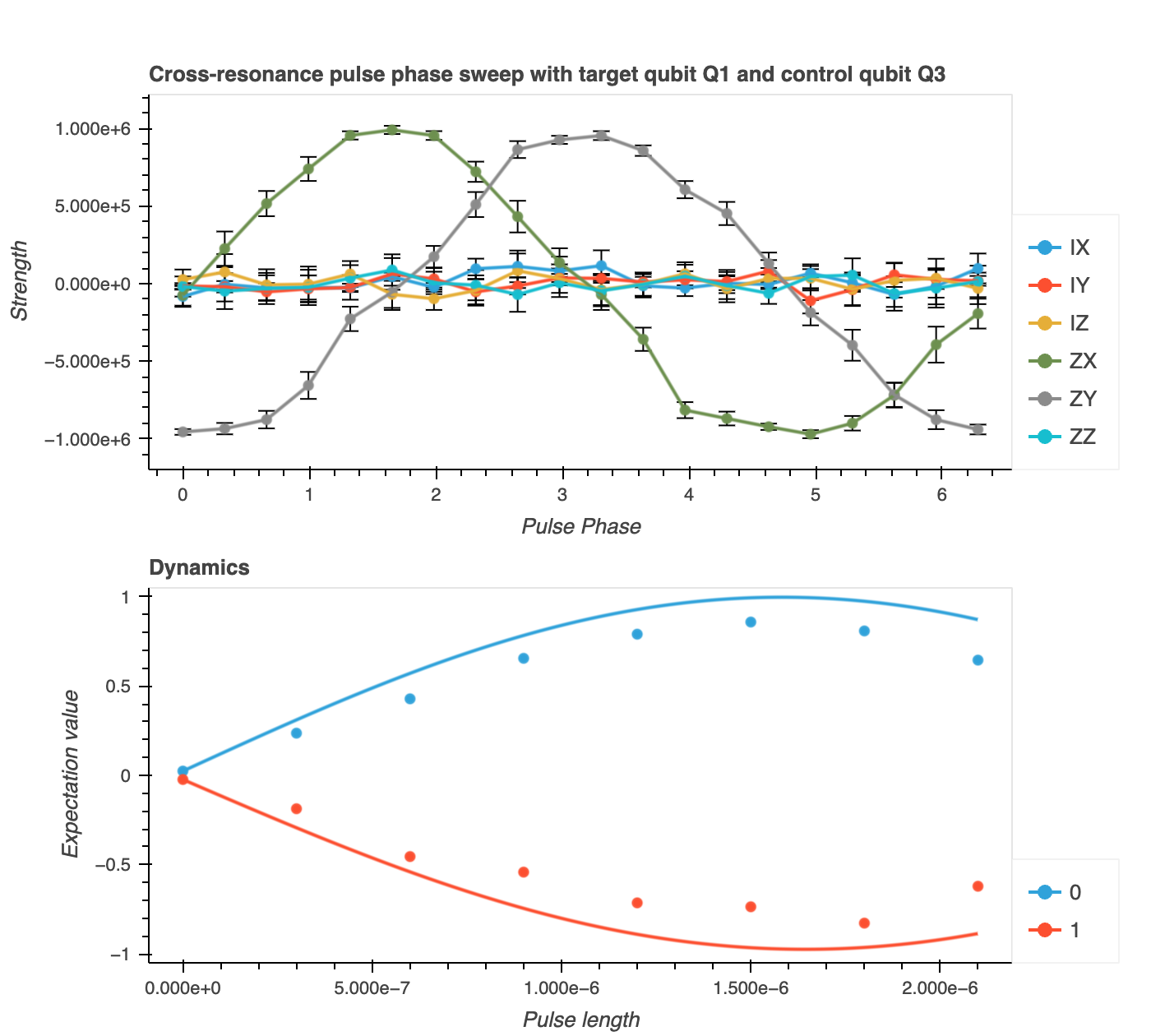Cross resonance phase sweep¶
The notebook implements Cross Resonance by sweeping the control phase and pulse duration
Description¶
As explained in the Cross Resonance Amplitude Sweep, two-qubit entangling operations can be realized using a microwave-activated cross-resonance interaction1. This interaction is enabled by applying a cross-resonant drive tone, corresponding to a qubit drive resonant with a neighboring qubit's transition. The local drive on one qubit (\(Q_C\), the control qubit), resonant with the first transition frequency of the other qubit (\(Q_T\), the target qubit), introduces an interaction between them. The interaction Hamiltonian depends on the cross-resonance pulse amplitude, \(\Omega_{12}\), but also on its phase. In this notebook, we perform a similar experiment as in the previous Cross Resonance Amplitude Sweep experiment. However, we fix the drive amplitude and only vary the drive phase and pulse duration.
For more theoretical details, please refer to the Cross Resonance Amplitude Sweep experiment.
Experimental steps¶
-
Defining the circuits needed to perform cross-resonance tomography, the method
_build_single_qubit_ins-\tructionsinside the classCrossResonanceTomographyreceives qubit characterization and constructs a dictionary containing three key-value pairs:-
ctrl_rx180p: It creates a gate instruction namedrx180pfor the control qubit. The frequency is set to the value obtained from the characterization. -
target_rx90p: It creates a gate instruction namedrx90pfor the target qubit. The frequency is set to the value obtained from the characterization, and thexy_angleis set to0. -
target_ry90m: It creates a gate instruction namedry90mfor the target qubit. The frequency is set to the value obtained from the characterization, and thexy_angleis set to-np.pi / 2.
-
-
For each pair of the control qubit states (0-1 states) and expectation values in the \(\sigma_x\), \(\sigma_y\), and \(\sigma_z\) bases, denoted as
(ctrl_state, exp_val), we perform aCrossResonanceAmplitudeSweep. This process entails applyingCrossResonanceTomographywhile sweeping throughpulse_phasesandpulse_lengths:-
If
ctrl_state == 1, appendctrl_rx180p. -
Applying a
cr_pulse(\(\hat{ZX}\)):-
If we set
echo=True,cr_pulseconsists of an echo-gate scheme (to reduce errors in the calibration, a cancellation tone can be applied2. A \(\hat{ZX}\) gate can be formed with tworx180gates on the control qubit. -
If we set
echo=False,cr_pulseconsists of actrl_rx180ppulse.
-
-
Measuring the resonator transmission and collect the \(I\) and \(Q\) signals:
-
Applying
target_ry90mto measure the qubit in the \(\sigma_x\)-basis. -
Applying
target_rx90pto measure the qubit in the \(\sigma_y\)-basis. -
No extra pulse is applied to measure the qubit in the \(\sigma_z\)-basis.
-
-
Analysis steps¶
-
Computing the resonator's amplitude (
amplitude) signal as a function ofpulse_phasesandpulse_lengths. Here, we predict the qubit state from the \(IQ\) data by applying thecomposite_discriminatorobtained in the Correlated Readout Error experiment. -
Computing the
expectation_values(omega_x,omega_y,omega_z) in the (\(\sigma_x\), \(\sigma_y\), \(\sigma_z\)) basis using the populations obtained in step 1. -
Computing the off-resonant control qubit drive terms, cross-resonance interaction terms, and rotations on the target qubit (
hamiltonian_param) as functions ofpulse_phases, i.e.,["IX", "IY", "IZ", "ZX", "ZY", "ZZ"]. We utilize thefit_cross_resonance_curvesfunction, employing thecr_propagatorandpropa-\gate_statefunctions to simulate quantum states based on the input parameters (omega_x,omega_y,omega_z) from 2. On one hand,cr_propagatorcalculates the propagator for a quantum gate corresponding to the cross-resonance interaction over a small time interval. It constructs a 3x3 matrix generator based on the input angular frequencies (omega_x,omega_y,omega_z) and returns the matrix exponential of the generator matrix multiplied by the time stepdt. On the other hand,propagate_stateiteratively applies the previous propagator to the initial state at each time point in the listts(pulse_lengths).
-
Chad Rigetti and Michel Devoret. Fully microwave-tunable universal gates in superconducting qubits with linear couplings and fixed transition frequencies. Phys. Rev. B, 81:134507, Apr 2010. doi:10.1103/PhysRevB.81.134507. ↩
-
Sarah Sheldon, Lev S. Bishop, Easwar Magesan, Stefan Filipp, Jerry M. Chow, and Jay M. Gambetta. Characterizing errors on qubit operations via iterative randomized benchmarking. Phys. Rev. A, 93:012301, Jan 2016. doi:10.1103/PhysRevA.93.012301. ↩
